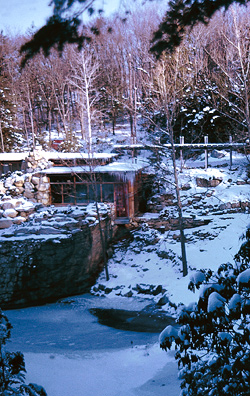
The Threat
The primary threats to the site relate to 1) vegetation management and maintenance, and 2) the preservation of the Manitoga's paths and related landscape character and features. As was noted above, hemlock woolly adelgid is killing its eastern hemlock, and deer are browsing whatever few seedlings the stressed hemlocks manage to produce (in fact, the deer browse all tree seedlings except black birch [ Betula lenta ]). Several of Russel Wright's paths and views depend on the deep shade cast by the branching pattern of hemlocks. The drama of the Morning Walk (with its bright openings at the easterly end of a hemlock "tunnel") has been lost; the Secret Room (a niche in the quarry wall where Wright would evade unwanted visitors) is now clearly in view and visitors no longer can experience the orchestrated sequence at the trailhead that once dove from sunlit Mary's Meadow up a rocky hemlock-darkened slope. Manitoga, Inc. can implement the recent policy recommendations of the Landscape Restoration Committee. These will keep hikers safe from falling trees, will treat adelgid where feasible, identify and protect hemlock seedlings where they occur, and address the deer browse issue. However, the three latter items will require funding and personnel beyond the site's current resources.
Due to lack of funding, Manitoga's staff has been unable to care for the special features along Russel Wright's paths, particularly in the outer landscape, and they are now seriously in need of restoration. For example, the Laurel Field is a hillside of high oak canopy, with an understory of mountain laurel ( Kalmia latifolia ) cascading toward a glade rimmed with other ericaceous shrub species. The laurels have grown rangy, blocking the impressive view up the slope and forming a tall wall around the glade. The display of flowering dogwoods in Mary's Meadow used to be glimpsed from the living room and terraces of Dragon Rock. The intervening slope is now clothed in mature hardwoods and shrubs. The present view of the quarry from the house is beautiful, but the tour interpretation of the original view -Wright's reminder of his late wife's favorite feature-is not supported by the present landscape. The stonework on paths is meant to guide walkers and look as if it is part of rock outcrops. Soil erosion makes these unusable, however, and hikers circumvent the steps. Ferns meant to brush one's legs in passing have been trampled, and the erosion worsens.
Manitoga is now in the process of inventory and assessment of the threat to the character and features of Russel Wright's paths. It then will establish a protocol and obtain costs estimate for restoring the design intent and effect. Thus, Manitoga will be ready to undertake landscape preservation projects as funding and/or volunteer labor become available.

